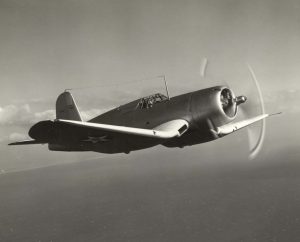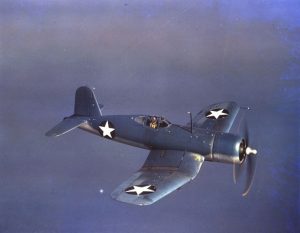Aviation Archives: F4U Corsair
Contributor: Riley Yelverton
Sources: Sikorsky Archives, National Museum of the United States Navy
On May 29, 1940, Vought-Sikorsky Aircraft Division test pilot Lyman A. Bullard, Jr. took the U.S. Navy’s new prototype fighter, the XF4U-1, Bu. No. 1443, for its first flight at Bridgeport Municipal Airport, Connecticut. Designed by Rex Buren Beisel, this prototype evolved into the iconic F4U Corsair.

The F4U Corsair in flight, June 1940. Courtesy of Sikorsky Archives
The F4U Corsair was a single-seat, single-engine fighter, designed for U.S. Navy aircraft carriers. The XF4U-1 measured 30 feet (9.14 meters) in length, with a wingspan of 41 feet (12.5 meters) and a height of 15 feet, 7 inches (4.75 meters). It weighed 7,576 pounds (3,436 kilograms) empty and 9,374 pounds (4,252 kilograms) at gross weight.
Initially powered by the experimental Pratt & Whitney R-2800 X-2 (Double Wasp A2-G) and later the R-2800 X-4 (Double Wasp SSA5-G), both engines were two-row, 18-cylinder radial engines. The X-2 was rated at 1,500 horsepower at 2,400 rpm at 7,500 feet (2,286 meters), while the X-4, an X-2 with an A5-G supercharger, was rated at 1,600 horsepower at 3,500 feet (1,067 meters). The X-4 had a compression ratio of 6.66:1 and used a two-speed, two-stage supercharger, making it the most powerful engine on a single-engine fighter at that time. It drove a 13 foot, 4 inch (4.064 meter) diameter, three-bladed Hamilton Standard Hydromatic propeller.

Vought-Sikorsky F4U-1 Corsair, 1942. Courtesy of U.S. Navy
The large propeller necessitated the Corsair’s distinctive inverted gull wing, which provided the necessary ground clearance and improved aerodynamics. The XF4U-1 had a maximum speed of 378 miles per hour (608 kilometers per hour) at 23,500 feet (7,163 meters). Although it was not the first U.S. single-engine fighter to exceed 400 miles per hour in level flight, it did achieve a ground speed of 405 miles per hour during a flight between Stratford and Hartford, Connecticut.
Several design changes were made before the Corsair went into production, including relocating fuel tanks to accommodate six Browning AN-M2 .50-caliber machine guns and ammunition, which also moved the cockpit rearward. In total, 12,571 Corsairs were produced by Vought-Sikorsky Aircraft Division, Goodyear Aircraft Corporation, and Brewster Aeronautical Corporation. The Corsair served the U.S. Navy and Marine Corps during World War II and the Korean War, and saw action in other countries’ armed forces, with its last known combat use in Central America in 1969.







